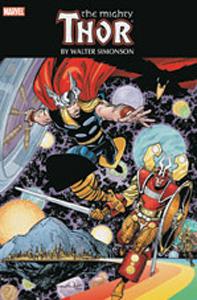A Thousand Pages of Thor
Thor by Walter Simonson Omnibus, by Walter Simonson ’68 (Marvel Comics)
Reviewed by Josh Bell ’02
 |
[Comics] Thanks to the high-profile release of the Thor movie, Marvel Comics has gone back to the character’s most creatively vibrant period and released Thor by Walter Simonson Omnibus, which lovingly restores nearly 1,200 pages of writer/artist Simonson’s work on the superhero series from 1983 to 1987. Considered by many comic-book fans to be the definitive take on the Marvel version of the Norse god of thunder, Simonson’s Thor integrated elements of Norse and Celtic mythology that had fascinated the author for years. Under Simonson’s direction, Thor was both grandiose and playful, with stories that ranged from the epic saga of the world-ending villain Surtur to a wonderful arc that found the hero transformed into a frog by his mischievous brother Loki.
The Omnibus begins with Simonson’s introduction of Beta Ray Bill, an equine-faced alien who proved worthy of lifting Thor’s hammer. In quick succession, Simonson brought in this major new player and did away with Thor’s frail civilian alter ego, Donald Blake, refocusing the series on the mystical realm of Asgard and Thor’s fellow gods. Sure, Simonson’s Thor still interacted with other Marvel superheroes and remained a member of the Avengers, but those mundane earthbound adventures are some of the least-exciting stories in the Omnibus (Thor’s time as a frog excepted). Instead, Simonson focused on the noble gods, as well as their ignoble counterparts, including Loki, the Frost Giants, the dark elf Malekith and the seductress Lorelei. Simonson’s Thor isn’t just a facsimile of a mythological figure imported into a comic book; he is an active participant in the creation of new and exciting myths.
The story of Surtur is chief among them, and it is also a perfect example of Simonson’s skill with long-term plotting. Numerous threads run through Simonson’s stories, interweaving and intermingling and sometimes coming to prominence in unexpected ways. Although Simonson delivers massive set pieces, he never neglects the emotional development of his characters. The most fascinating figure in his Thor isn’t the title character but rather Balder the Brave, a proud warrior who renounces killing after facing the souls of the men he has slain in battle. Balder goes from contemplating suicide to ruling Asgard, all with a quiet dignity that stands in contrast to Thor’s jovial pomposity.
About two-thirds of the issues in the Omnibus feature art by Simonson; Sal Buscema drew the remaining third. Buscema is a solid superhero artist in the classic mold, but Simonson’s art has more life to it; he favors close-ups that show the emotion and thought in his characters’ eyes, but he is equally adept at sprawling action scenes. The Omnibus also features about 50 pages of sketches and other supplemental material, including drawings Simonson made during his time at Amherst, when he first discovered Thor comics. As a student, he planned out many of the details and imagery of the Surtur storyline, holding onto it for more than a decade until he had the chance to bring it to fruition. That kind of passion and perseverance infuses Simonson’s Thor from the first page all the way to the last.
Josh Bell, the film editor of Las Vegas Weekly, reviewed David O. Russell’s The Fighter in the Spring 2011 Amherst magazine.